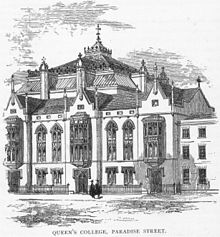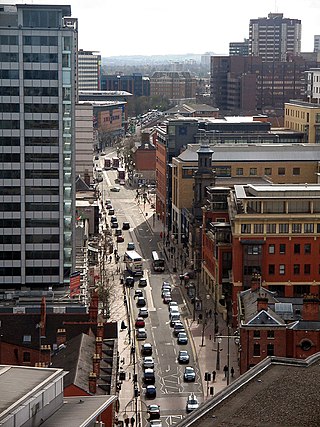
Broad Street is a major thoroughfare and popular nightspot centre in Central Birmingham, England. Traditionally, Broad Street was considered to be outside Birmingham City Centre, but as the city centre expanded with the removal of the Inner Ring Road, Broad Street has been incorporated into the new Westside district of the city centre due to its position within the A4540 road.

Chamberlain Square or Chamberlain Place is a public square in central Birmingham, England, named after statesman and notable mayor of Birmingham, Joseph Chamberlain. The Victorian square was drastically remodelled in the 1970s, with most of the Victorian buildings demolished and the construction of the Brutalist Central Library. Re-landscaping occurred most recently when the square was closed to the public for five years until March 2021 for remodelling as part of the Paradise scheme.
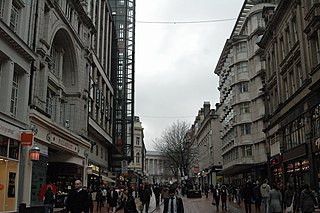
New Street is a street in central Birmingham, England. It is one of the city's principal thoroughfares and shopping streets linking Victoria Square to the Bullring Shopping Centre. It gives its name to New Street railway station, although the station has never had direct access to New Street except via Stephenson Place and latterly Grand Central shopping centre.

Five Ways is an area of Central Birmingham, England. It takes its name from a major road junction, now a busy roundabout to the south-west of the city centre which lies at the outward end of Broad Street, where the Birmingham Middle ring road crosses the start of the A456.

Marston Green railway station is a station serving Chelmsley Wood and Marston Green in the Metropolitan Borough of Solihull and the Birmingham suburbs of Lea Hall and Sheldon in the West Midlands County, England. The station, and all trains serving it, are operated by West Midlands Trains.
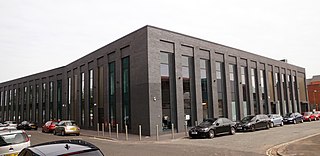
The Birmingham Assay Office, one of the four assay offices in the United Kingdom, is located in the Jewellery Quarter, Birmingham. The development of a silver industry in 18th century Birmingham was hampered by the legal requirement that items of solid silver be assayed, and the nearest Assay Offices were in Chester and London. Matthew Boulton and Birmingham's other great industrialists joined forces with silversmiths of Sheffield to petition Parliament for the establishment of Assay Offices in their respective cities. In spite of determined opposition by London silversmiths, an Act of Parliament was passed in March 1773, just one month after the original petition was presented to Parliament, to allow Birmingham and Sheffield the right to assay silver. The Birmingham Assay Office opened on 31 August 1773 and initially operated from three rooms in the King's Head Inn on New Street employing only four staff and was only operating on a Tuesday. The first customer on that day was Matthew Boulton.

Queensway is the name of a number of roads in central Birmingham, England. The name most often refers to the Queensway tunnel, part of the A38. However the name is also used as a suffix of several other roads and circuses, such as Smallbrook Queensway and Colmore Circus Queensway; all of these were once part of the historic A4400 Inner Ring Road, which was often called collectively the Queensway.

Corporation Street is a main shopping street in Birmingham city centre, England. Though it has a distinct southern terminus – the junction of New Street and Stephenson Place, adjacent to the entrance of New Street station – the location of its northern terminus is debatable.
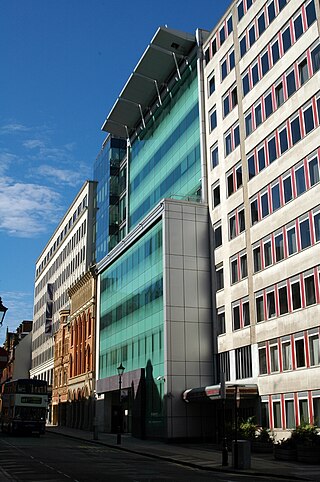
Edmund Street is a street located in Birmingham, England.
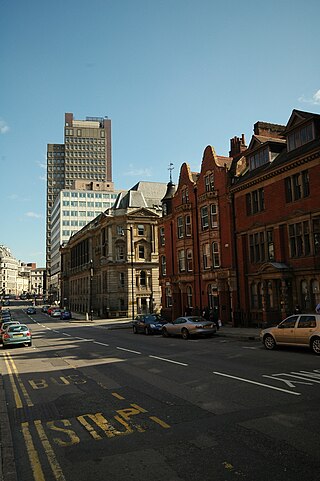
Newhall Street is a street located in Birmingham, England.
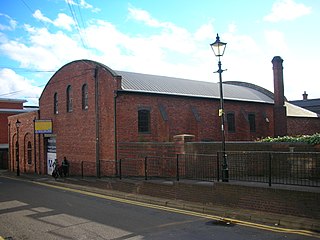
The Gas Retort House at 39 Gas Street, Birmingham, England is the last remaining building of Birmingham's first gas works.
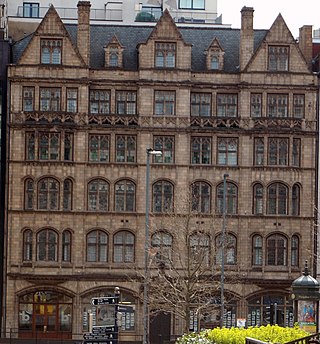
Queen's College was a medical school in central Birmingham, England, and a predecessor college of the University of Birmingham. It was founded by surgeon William Sands Cox in 1825 as The Birmingham Medical School, a residential college for medical students. Cox's ambition was for the college to teach arts, law, engineering, architecture and general science. It was the first Birmingham institution to award degrees, through the University of London.
Smithfield was an inner-city area of Birmingham, England, southeast of the Bull Ring markets.

Colmore Row is a street in Birmingham City Centre in the centre of Birmingham, England, running from Victoria Square to just beyond Snow Hill station. It is traditionally the city's most prestigious business address.
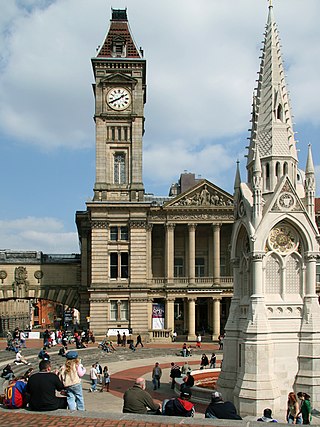
Big Brum is the local name for the clock tower on the Council House, Birmingham, England. Built in 1885, the clock tower is part of the first extension to the original Council House of 1879 and stands above the Museum & Art Gallery. The clock tower, Museum & Art Gallery and Council House were designed by architect Yeoville Thomason and form a single block. The clock was donated by Follett Osler, a local pioneer in the measurement of meteorological and chronological data. The clock mechanism was supplied by Gillett & Co. of Croydon, and the clock-tower and lofty entrance portico were considered the "most conspicuous features" of the exterior upon opening.
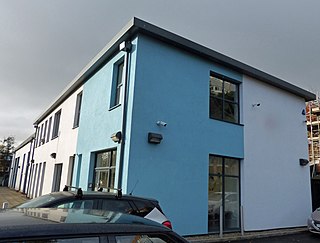
Birmingham Central Synagogue is an Orthodox synagogue situated in Edgbaston, Birmingham, England.

The Crescent was a part-completed Regency-style terrace in central Birmingham, England. The scheme was first proposed in 1788, construction started in 1795 and was discontinued the same year. The partially-completed terrace was finally demolished in the mid- to late 1960s. Like other late 18th and early 19th century crescent terraces in Britain and Ireland, it took its inspiration from The Crescent, Bath, designed by John Wood the Younger and built 1767 to 1774.

Paradise, formerly named Paradise Circus, is the name given to an area of approximately 7 hectares in Birmingham city centre between Chamberlain and Centenary Squares. The area has been part of the civic centre of Birmingham, England since the 19th century when it contained buildings such as the Town Hall, Mason Science College, Birmingham and Midland Institute buildings and Central Library. The site was redeveloped from 1960 to 1975 into the present Paradise Circus based within a roundabout on the Inner Ring Road system containing a new Central Library and School of Music. From 2015, Argent Group will redevelop the area into new mixed use buildings and public squares.
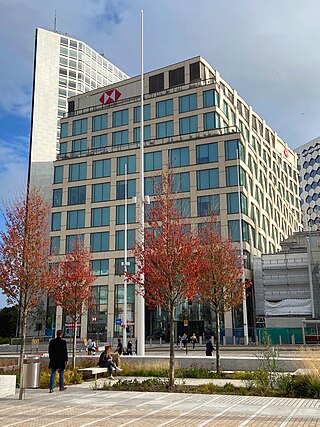
One Centenary Square, is a 55 metres (180 ft), eleven storey building between Alpha Tower and the former Birmingham Municipal Bank headquarters on Broad Street in Birmingham, England. The building serves HSBC Bank as their UK headquarters for the personal and business banking operations.
Witney Rural District was a rural district in Oxfordshire, England from 1894 to 1974. It surrounded but did not include the town of Witney.


